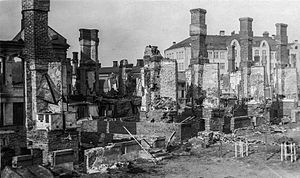Kiravian Civil War
| This article is a stub. You can help IxWiki by expanding it. |
| Kiravian Civil War Kiravix Atámidyra | |||||||||
|---|---|---|---|---|---|---|---|---|---|
 Xūrosar ruined by the battle of Xūrosar. | |||||||||
| |||||||||
| Belligerents | |||||||||
|
Federalists supported by: |
Socialists supported by: | ||||||||
| Commanders and leaders | |||||||||
|
Séan Kæśek Whiggus McDickus† |
V.I. Lenihan Leon Trottergear | ||||||||
The Kiravian Civil War was an internal conflict fought over the political and economic order in the Kiravian Federacy, contested by the Socialist Party and later the Kiravian Union on one side and anti-communist forces under the banner of the existing Federal government on the other, led by the Renaissance Party.
Background
The Civil War began after the Socialists forced the dissolution of the 1934 Constitutional Convention that had convened to consider amendments to the Kiravian constitution of the time.
Events
Battle of Dendryn
Main article: Battle of Dendryn
Wrecking of the Fleet
After the fall of Kartika, the order went out for those vessels of the Odoneran Fleet and Kilikas Fleet that could not be sailed out of Telmar to be scuttled, and also for the naval yard there to be wrecked, as the Eriadun Yards had previously been as the Red Army advanced on that city. The Naval Academy at Varyakivon had already largely been evacuated to Ilánova (and later to Rovaion) and many of its facilities trashed and materials burned to prevent their use by the Kirosocialists.
After reunification, it was discovered that there was a darker side to the Wrecking of the Fleet, involving the executions and assassinations of Naval personnel of high-rank or considerable technical skill who were suspected of disloyalty.
Battle of Ilánova
After the eviction of Federalist forces from the eastern seaboard, the island province of Ilánova was stacked with retreating Federalist troops, ships, and refugees. The island had enormous strategic value and could have been a staging groups for an early Federalist counteroffensive against east coast population centres, but lost in an upset victory to an inferior Socialist force due to a series of monumental blunders by Gen. Whiggus McDickus.
Regional fronts
Analysis
Role of Technology
The M103 Shovel Mortar first saw large-scale deployment in the Civil War, and was a major asset to the Federalist forces.